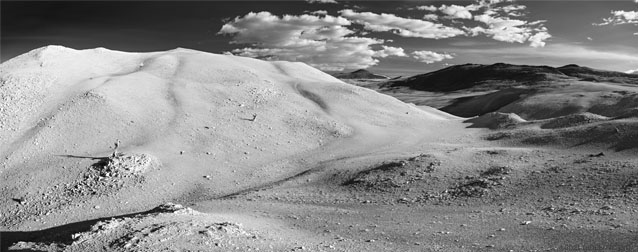Where do We Go From Here? Fujifilm Medium Format vs 35mm vs Blind Spots for Both
re: Confusticating Choice: Sony A7R V with Pixel Shift vs Fujifilm GFX100S
re: Sony A7R V Pixel Shift vs Fujifilm GFX100S @ 26/21mm: the Medium Format Killer Keeps Delivering
re: Reader Comment: Fujifilm GF Lens Performance
re: golden age of photography
Reader Claude F recently asked me whether I thought that Fujifilm GFX100S offered a meaningful advantage over 35mm. That’s the subject of a whole essay, but in a nutshell, there’s not a whole lot to distinguish the 100MP GFX100S and its actual lenses from the 60MP Sony A7R V used with high-grade lenses. Not when you taking into account lens performance and working aperture for depth of field, etc. Both are better than the other, depending, and within the same image both can be better and worse. In other words, the argument for the GFX100S is not strong.
One has to give Fujifilm a ton of credit for pushing forward on the medium format front... up through 2019 or so with the arrival of the Fujifilm GFX100. But it’s 4 years later here in 2023, and the value proposition is marginal compared to 35mm, even for landscape. The platform is aging and not showing any signs of life—cameras including variants and/or lenses.
Lens performance
Fujifilm GF lenses are impressive in outperforming virtually all prior medium format lenses (ditto for Hasselblad XCD lenses), and at impressively low prices. Outstanding value, great progress, but it’s not enough.
Any comparison with a lens like the Voigtlander FE 50mm f/2 APO-Lanthar quickly shows that capture detail on Fujifilm medium format is lens-limited over a good part of the frame, but this is not so on Sony mirrorless.
What we need is better lenses. And what I want is Voigtlander APO-style lenses for Fujifilm. But we don’t have that or anything close—the non-Fujifilm lenses for Fujifilm medium format are pretty much junk grade.
Until and unless we see aggressively high performance lenses for it, Fujifilm medium format will continue to under-deliver on total sharpness. The central area is fine, it’s those outer zones at issue.
Monochrome
There is one obvious area that Fujiflm could really shake things up: deliver a GFX100M monochrome-sensor camera. That would substantially increase the resolved detail (no Bayer matrix demosaicing) and reduce the lens performance issues, since green/orange/red filtration effectively improves lens performance by reducing chromatic-related issues.
Actually, it’s surprising that Fujifilm has not acted on the monochrome front since it would be a compelling strategic addition to the Fujifilm medium format platform, locking in the decision for me at least.

Fujifilm GFX100S + Fujifilm GF 50mm f/3.5 R LM WR @ 41.1mm equiv (50mm) + polarizer Breakthrough Photography X4
ENV: White Mountains, altitude 11500 ft / 3505 m, 55°F / 12°C
RAW: LACA corrected, vignetting corrected, +20 Whites, +20 Clarity, USM {8,50,0}
[low-res image for bot]
Eliminate the make-work “features”
There is a low-hanging fruit in eliminating the make-work capture stuff.
For example, why do I have to ever consider exposure when I’m on a tripod when the camera could evaluate the scene and deliver the best possible exposure automatically? Ditto for camera shake issues, motion blurs, focus accuracy and zone of focus. All such things can be fully automated. Let the photographer do the creative part, and let the camera do the mundane stuff.
Capture quality
Not more megapixels, but better megapixels is what I want. To a certain extent, Sony 4-shot pixel shift delivers that, but with a high nuisance factor.
The entire industry has stagnated on the image capture front: a Sony A7R V has many nice improvements, but it offers no meaningful superiority to the Sony A7R IV.
The industry (all formats) seems to be stuck in an image quality rut—little has changed in 4-5 years. We do not have better color rendition a la PhaseOne Trichromatic, we do not have high-precision pixel shift outside of high-end multishot backs for studio use, we do not have true-color sensors, etc. We do have crappy multi-shot (Fujifilm), and usable pixel shift (Sony), but nothing stands out as really good.
It sure looks like we are not going to see sensor breakthroughs. Which means that camera makers need to take a fresh look at getting more out of the technology they already have.
The onus is on the high-end offering (Fujifilm medium format) to figure this out, and offer a clear and compelling capture mode 35mm-beater.
Michael Erlewine writes:
See Reader Comment: Nikon Mirrorless, Nikon NIKKOR Z Lenses, Voigtlander Lenses for Nikon Mirrorless.
Jason W writes:
The new GFX TS Lenses could be APO performance and high quality. They're slow and effectively large format image circles, so, not quite clear how good they will actually be, but there's nothing else out there like that. They will likely be quite heavy though, although if you're doing TS you likely don't care.
Global shutter would be a major thing for the GFX, both for shooting stills and video. There's a 127 mpx industrial Sony sensor that seems like a possible option, maybe. They'd need some new lenses to make it viable for video, not everyone can afford a Premista.
I think adding in-camera frame averaging would be a nice addition to the GFX100S, provided Fuji kept it in RAW and not some JPEG only or post processing TIFF f*ckery.
PDAF isn't going anywhere and it's fanciful to think any company would remove it from the stack on a flagship. If you're a landscape photographer that can afford to be operating at that level of scrutiny then you aught to just buy a Phase One back.
DIGLLOYD: the tilt/shift lenses are not an answer at all IMO. I am not going to deal with an f/5.6 lens, or lugging it around and they are niche usage scenarios.
Global shutter = irrelevant for most things.
Frame averaging is low hanging fruit yet not done by Sony or Nikon or Canon... weird.
I disagree on that last point—saying one ought to spedn $65K on a bulky and heavy system because your $10K system could be better is bad thinking IMO.























